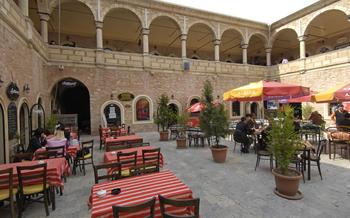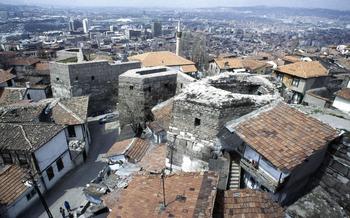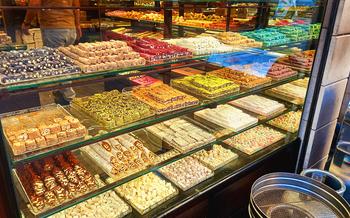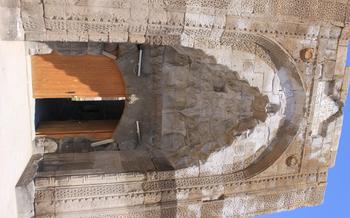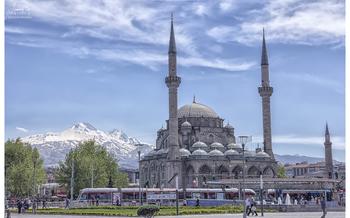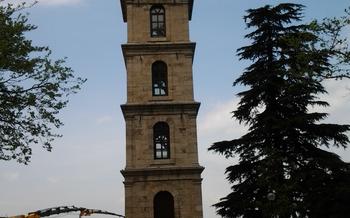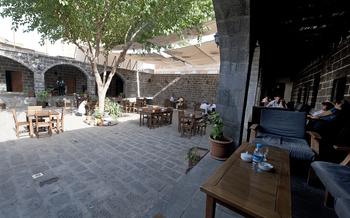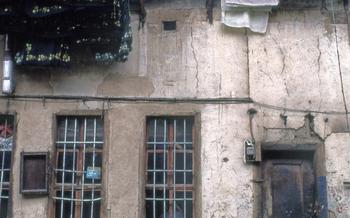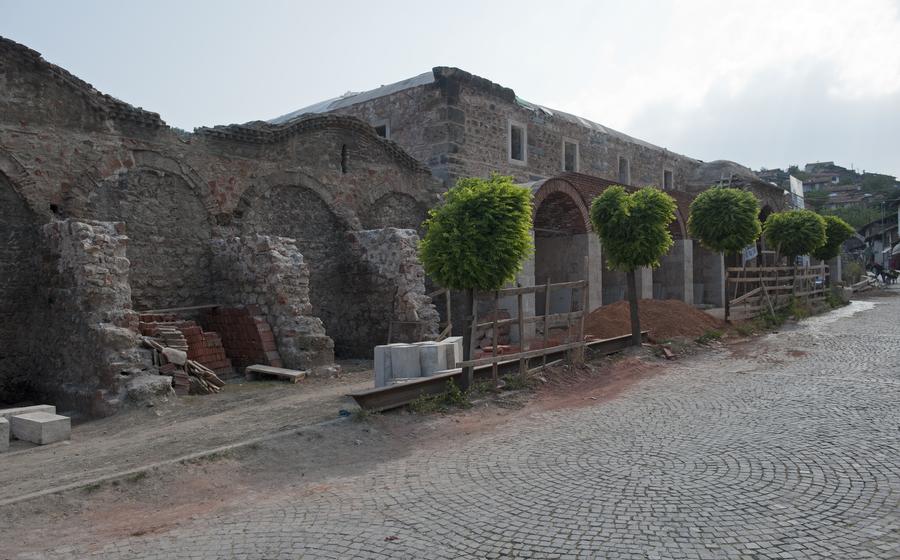
Deveciler Hanı
- Historical Significance
- Architectural Marvel
- Courtyard Serenity
- Stables and Caravans
- Guest Rooms and Hospitality
- Artisans and Craftsmen
- Turkish Delights
- Cultural Events and Exhibitions
- Shopping for Souvenirs
- Historical Context of Tokat
- Getting to the Deveciler Hanı
- Opening Hours and Admission
- Photography and Social Media
- Dress Code and Etiquette
- Insider Tip: Hidden Gems
Historical Significance
The Deveciler Hanı, a testament to Turkey's rich history, stands as a symbol of cultural exchange and architectural brilliance. Built in the 15th century, this caravanserai once served as a sanctuary for weary travelers and traders traversing the Silk Road, a bustling network of trade routes connecting East and West. Its strategic location in Tokat, a city known for its diverse cultural heritage, made it a crucial stop along this ancient path.
As a caravanserai, the Deveciler Hanı provided a haven for merchants transporting precious goods, such as spices, silks, and jewels. With its sturdy walls and spacious courtyard, it offered protection from harsh weather, bandits, and wild animals that roamed the vast landscapes. Within its walls, travelers could rest, replenish their supplies, and exchange stories and experiences, fostering a sense of community and camaraderie.
The architectural style of the Deveciler Hanı reflects a harmonious blend of Seljuk and Ottoman influences, showcasing the region's rich artistic heritage. Its intricate carvings, calligraphy, and tilework bear witness to the skill and artistry of the craftsmen who meticulously adorned its facade and interiors. The han's well-preserved condition is a testament to the ongoing efforts to maintain its authenticity and historical integrity.
Architectural Marvel
The Deveciler Hanı stands as a testament to the architectural prowess of the Seljuk and Ottoman empires. Its stunning facade is adorned with intricate carvings, calligraphy, and tilework that showcase the artistry and craftsmanship of Islamic design. The main entrance, a grand arched portal, leads to a central courtyard surrounded by two-story buildings. The courtyard, with its serene fountain and shaded seating areas, provides a welcome respite from the bustling city outside.
The guest rooms, arranged around the courtyard, are simple yet functional, catering to the basic needs of weary travelers. Each room features a traditional Turkish bed, known as a sedir, built into the wall. The stables, located on the ground floor, once housed the animals that carried traders and travelers along the Silk Road. These spaces have been repurposed into shops and workshops, adding to the vibrant atmosphere of the han.
The Deveciler Hanı seamlessly blends traditional and modern elements, creating a harmonious masterpiece. The original architecture has been preserved and restored, while modern amenities have been added to ensure the comfort of visitors. This careful balance allows the han to retain its historical charm while catering to the needs of contemporary travelers.
Courtyard Serenity
Step into the central courtyard of the Deveciler Hanı, and let the tranquility wash over you. This peaceful oasis, nestled within the bustling city of Tokat, offers a welcome respite from the vibrant energy of the surrounding streets.
Find a shady spot beneath the ancient trees, and let your gaze wander over the architectural wonders that surround you. Intricate carvings, delicate tilework, and graceful arches create a harmonious symphony of Islamic craftsmanship.
Sip a cup of Turkish tea or coffee, savoring the simple pleasures of life as you soak in the serenity of this historic setting. Close your eyes and listen to the gentle sounds of birdsong and the soft murmur of conversation, carried by the breeze.
Capture the beauty of the courtyard with your camera, capturing the vibrant colors and intricate details that make this space so special. Let the Deveciler Hanı's courtyard be your sanctuary, a place to relax, reflect, and appreciate the timeless beauty of Turkish architecture.
Stables and Caravans
Venture into the stables of the Deveciler Hanı, where weary travelers once sought shelter for their animals and themselves. Imagine caravans of camels and horses filling the courtyard, laden with goods from distant lands. These caravans were a vital part of the Silk Road, a vast network of trade routes that connected East and West.
The Silk Road was not just about trade; it was also a conduit for cultural exchange and the spread of ideas. As caravans traveled from one place to another, they carried with them not only goods but also stories, customs, and beliefs. The Deveciler Hanı, as a hub of this vibrant trade, played a crucial role in facilitating these cultural interactions.
Stand in the courtyard and close your eyes. Can you hear the creaking of wagon wheels, the braying of donkeys, and the hum of conversation in a dozen different languages? Can you smell the spices and perfumes from faraway lands? This was the sound and scent of the Silk Road, a symphony of commerce and cultural exchange that left an indelible mark on the history of the world.
Guest Rooms and Hospitality
Step inside the guest rooms of the Deveciler Hanı and let your imagination transport you back in time. These simple yet functional spaces once provided weary travelers with a much-needed respite during their long journeys. Although basic in amenities, the rooms exuded a sense of warmth and comfort, catering to the essential needs of those who sought shelter within the han's walls.
Imagine the stories shared and friendships formed within these humble chambers. Travelers from distant lands, with diverse backgrounds and experiences, would gather here to rest, exchange tales of their adventures, and forge bonds that would last a lifetime. The han became a melting pot of cultures, where people from all walks of life came together under one roof, united by their shared experiences on the Silk Road.
The hospitality extended to guests at the Deveciler Hanı was a hallmark of Turkish culture. Travelers were welcomed with open arms and treated with the utmost respect. The innkeepers and staff went above and beyond to ensure that their guests felt comfortable and well-cared for. This tradition of hospitality continues to this day, as the han's modern-day operators strive to uphold the same level of care and attention that was offered to guests centuries ago.
Artisans and Craftsmen
Within the walls of the Deveciler Hanı, a vibrant community of artisans and craftsmen keeps traditional Turkish crafts alive. These skilled individuals, often referred to as ustalar, dedicate their lives to preserving and passing on ancient techniques and skills.
Observe them as they work with intricate precision, creating beautiful carpets, pottery, and jewelry. Each piece is a testament to their mastery and dedication to their craft. Learn about the techniques and skills passed down through generations, ensuring the continuity of these traditional arts.
Support local artisans by purchasing their unique creations as souvenirs. Not only will you take home a piece of Turkish craftsmanship, but you will also contribute to the preservation of this valuable cultural heritage. Engage with the artisans, ask questions, and delve into the stories behind their work. Discover the passion and dedication that drives them to create such exquisite pieces.
Turkish Delights
Indulge your senses with the delectable Turkish delights offered at the Deveciler Hanı's cafes and restaurants. Savor the sweetness of lokum, a traditional Turkish candy made with rosewater and pistachios, as it melts in your mouth, leaving a lingering flavor that will transport you to a world of culinary enchantment. Sip on a glass of çay, the ubiquitous Turkish tea, while enjoying the serene ambiance of the han. Experience the warmth of Turkish hospitality as you share a meal with fellow travelers, exchanging stories, and creating memories that will last a lifetime.
Cultural Events and Exhibitions
The Deveciler Hanı is not just a historical site but also a vibrant cultural hub. Throughout the year, the han hosts a variety of cultural events and exhibitions that celebrate Turkish heritage and traditions.
Immerse yourself in the mesmerizing rhythms of traditional Turkish music, performed by skilled musicians who bring centuries-old melodies to life. Experience the grace and elegance of Turkish dance, as performers twirl and spin in colorful costumes.
Explore art exhibitions showcasing the works of local and regional artists, who display their paintings, sculptures, and handicrafts. Discover the rich cultural tapestry of Tokat and the surrounding region through these artistic expressions.
Engage with local artists and learn about their creative process, gaining insights into the inspiration behind their works. Participate in workshops and demonstrations, trying your hand at traditional crafts such as carpet weaving, pottery, and jewelry making.
Attending cultural events and exhibitions at the Deveciler Hanı is a fantastic way to delve deeper into Turkish culture, appreciate the talents of local artists, and create lasting memories of your time in Tokat.
Shopping for Souvenirs
Within the walls of the Deveciler Hanı, you'll find a treasure trove of shops offering a diverse array of souvenirs and handicrafts. These shops are a testament to the rich artistic heritage of Tokat and provide a wonderful opportunity to support local artisans while finding unique gifts for your loved ones.
Hand-woven Carpets: Immerse yourself in the vibrant colors and intricate designs of hand-woven carpets, a symbol of Turkish craftsmanship. Each carpet tells a story, reflecting the weaver's artistry and cultural influences.
Exquisite Pottery: Discover the delicate artistry of Tokat's potters, who create beautiful ceramic pieces that range from traditional to contemporary designs. From intricate vases to decorative plates, these handmade items make for thoughtful and unique souvenirs.
Handmade Jewelry: Adorn yourself with exquisite jewelry crafted by local artisans, showcasing the beauty of precious metals and gemstones. From delicate necklaces and earrings to statement pieces, you'll find something to suit every taste and style.
Colorful Textiles: Indulge in the vibrant colors and patterns of Turkish textiles, a reflection of the country's rich cultural heritage. From hand-embroidered tablecloths to colorful scarves, these textiles add a touch of charm to any home.
Historical Context of Tokat
Tokat, the city where the Deveciler Hanı resides, boasts a rich and intriguing history that spans centuries. Once a significant stop along the Silk Road, Tokat served as a melting pot of cultures and civilizations. The city's strategic location attracted various empires, including the Romans, Byzantines, and Ottomans, each leaving their unique mark on its tapestry.
Explore the ancient Tokat Castle, a testament to the city's resilience and strength. Perched atop a hill, the castle offers breathtaking panoramic views and a glimpse into Tokat's past. The Grand Mosque, another architectural marvel, showcases exquisite Islamic craftsmanship and serves as a center of religious and cultural significance.
Immerse yourself in the Tokat Museum, a treasure trove of artifacts that narrate the city's fascinating journey through time. Discover ancient relics, traditional costumes, and intricate handicrafts that provide insights into Tokat's diverse heritage.
As you wander through Tokat's charming streets, admire the blend of architectural styles that reflect the city's multicultural past. From Ottoman mansions to Byzantine churches, each building tells a story, waiting to be uncovered.
Getting to the Deveciler Hanı
Reaching the Deveciler Hanı in Tokat is a breeze, with a range of transportation options at your disposal. Buses and trains offer convenient connections to Tokat from major cities in Turkey, while rental cars provide the freedom to explore the region at your own pace. Once in Tokat, follow clear directions and maps to effortlessly find the han, situated in the heart of the city. Guided tours are an excellent option for those seeking a deeper understanding of the han and its surroundings, with knowledgeable guides sharing insights into its history and significance.
Opening Hours and Admission
Plan your visit to the Deveciler Hanı according to its operating hours to avoid disappointment. The han is typically open to the public from 9:00 AM to 5:00 PM, seven days a week. Admission to the han is free of charge, allowing you to explore its wonders without any financial burden.
Consider visiting the han during the morning hours to experience its serene atmosphere and avoid the crowds that may gather later in the day. Alternatively, if you prefer a more vibrant experience, plan your visit during the afternoon or evening when the han is bustling with activity.
Whether you choose to visit during the han's busiest or quieter hours, remember to respect the historical significance of the site and maintain appropriate behavior. The Deveciler Hanı is a place of cultural and historical importance, and it is essential to treat it with the utmost care and respect.
Photography and Social Media
Capture the beauty of the Deveciler Hanı through the lens of your camera, immortalizing its architectural wonders and serene atmosphere. Respect the guidelines for taking pictures, ensuring you don't disturb other visitors or compromise the integrity of the site. Share your stunning photographs on social media, using relevant hashtags such as #DevecilerHani, #Tokat, and #TurkeyTravel. Inspire others to explore the rich cultural heritage of Turkey and Tokat, sparking their wanderlust and appreciation for historical landmarks. Engage with fellow travelers and photography enthusiasts online, sharing tips, experiences, and stories from your visit. Let your images and captions serve as a testament to the timeless allure of the Deveciler Hanı, encouraging others to embark on their own journey of discovery.
Dress Code and Etiquette
When visiting the Deveciler Hanı, it is important to observe appropriate dress code and etiquette to respect local customs and traditions. Dress modestly, covering your shoulders and knees, to show respect for the cultural and religious sensitivities of the region. Be mindful of your behavior and maintain a respectful attitude towards the historical significance of the site. Avoid loud noises, disruptive behavior, and littering to preserve the serene atmosphere of the han. Additionally, ask for permission before taking photos of people, especially women, as a sign of courtesy and respect for their privacy. By following these simple guidelines, you can ensure a pleasant and respectful visit to this historic landmark.
Insider Tip: Hidden Gems
Beyond the main attractions of the Deveciler Hanı, there are hidden gems waiting to be discovered. Explore the surrounding streets and alleys to find charming cafes, local restaurants, and unique shops that offer a glimpse into the daily life of Tokat. Ask locals for recommendations on off-the-beaten-track places to visit, such as a secluded garden or a rooftop terrace with stunning views of the city. Immerse yourself in the authentic atmosphere of Tokat, where history and tradition blend seamlessly with modern life.
